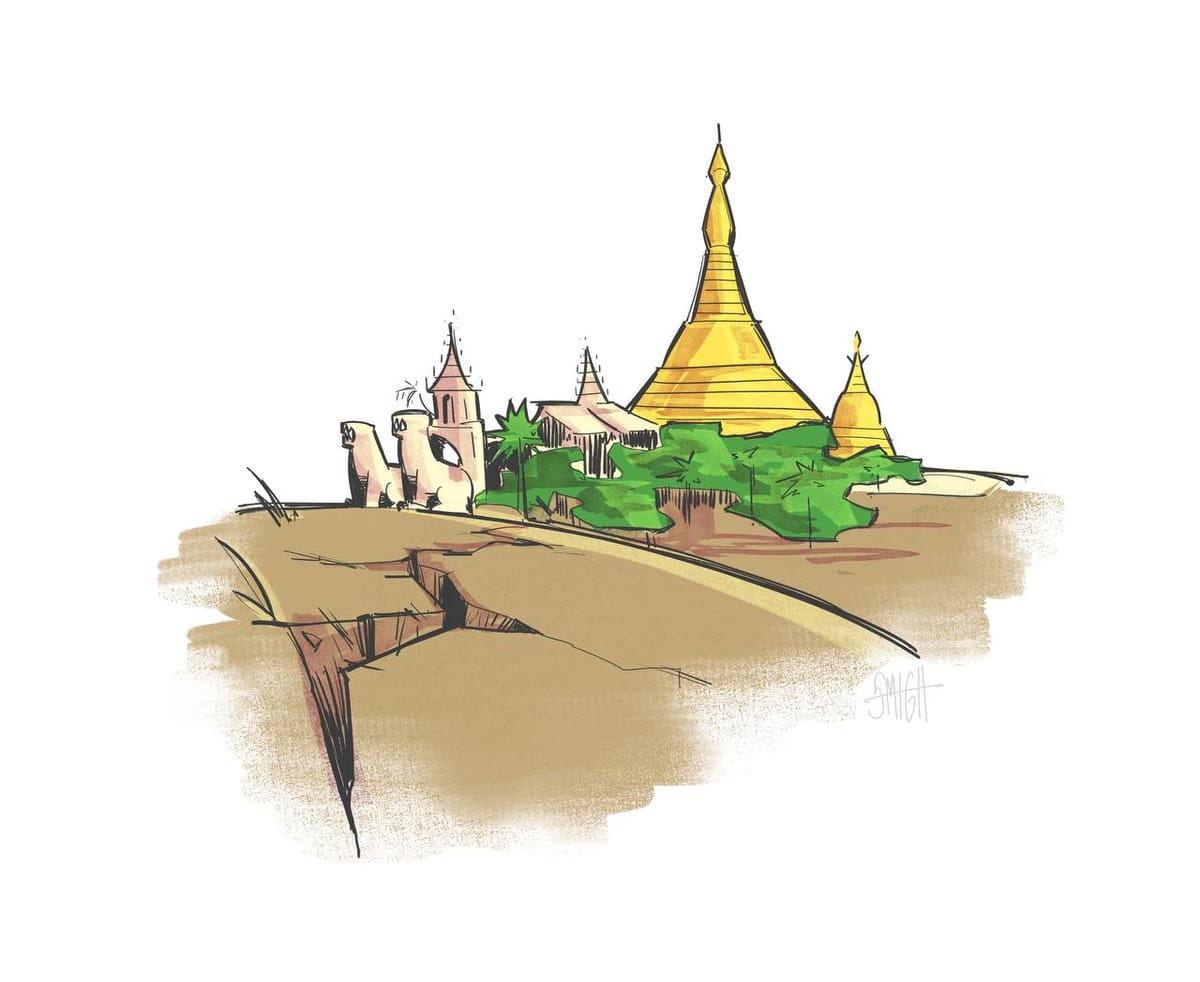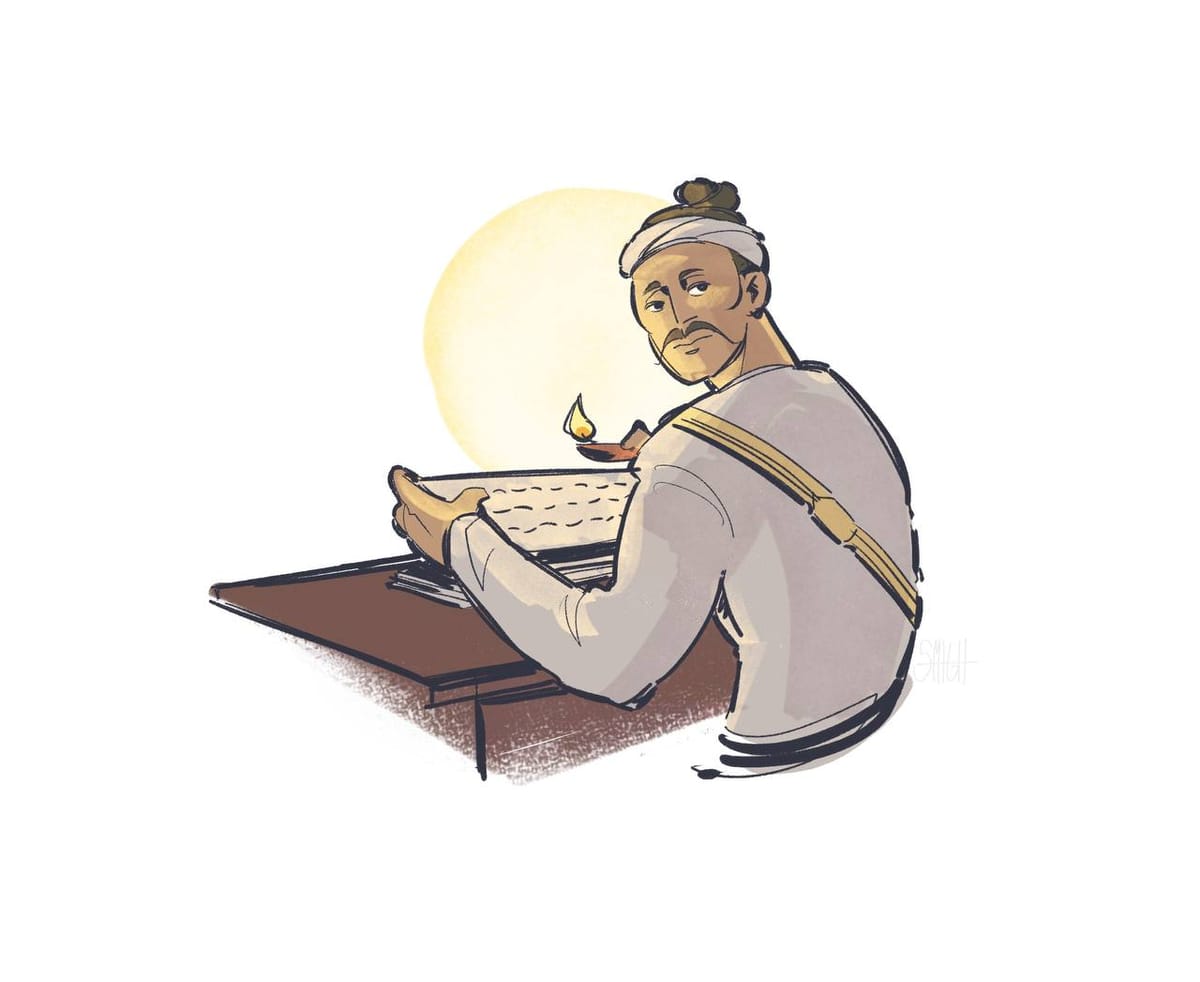
The earthquake that struck Sagaing on March 28, 2025, caused extensive damage. Among the numerous structures affected were Buddhist temples, monasteries, and pagodas deeply revered by Buddhists.
Some were completely destroyed, while others suffered partial damage. The Myatheindan Pagoda in Mingun, Kaunghmudaw Pagoda, Mahamuni Buddha in Mandalay, Thilamingalaung in Bagan... these are just some of the famous pagodas and temples that were damaged due to the earthquake.
These pagodas and temples are not only sacred Buddhist religious structures but also represent Myanmar's cultural heritage.
However, in Yangon, which is far from the earthquake's epicenter, the impact wasn't as severe. Therefore, Yangon's heritage sites remain intact. In Yangon, the Shwedagon Pagoda is not only the heart of Buddhist devotion but also a cultural icon and national symbol.
Now in 2025, while Mandalay and Sagaing's religious structures have suffered damage from natural disasters, a look back at history reveals that Yangon's Shwedagon Pagoda has also faced numerous natural disasters throughout its existence.
So it seems appropriate to talk about the worldly vicissitudes of the Shwedagon Pagoda, which is inseparable from the Myanmar people, in historical context.
What is Shwedagon
The Shwedagon Pagoda stands 326 feet tall and is located on Singuttara Hill in Yangon. The merchant brothers Taphussa and Bhallika had the opportunity to offer food to the Buddha and received eight hair relics from him. Upon reaching the kingdom of Okkalapa, they decided to enshrine four of these hair relics, and King Okkalapa established what would become the Shwedagon Pagoda. This is the brief history of the Shwedagon Pagoda as accepted by Buddhists.

Join Build Myanmar's Earthquake Relief Effort
We urgently invite to unite with Build Myanmar in supporting those affected by the devastating earthquake. Your contribution, no matter how small, can make a significant difference to families in crisis. To donate directly to our established emergency relief fund, simply scan the QR code in the image. Together, we can help our communities rebuild.
Historian Dr. Than Tun, however, states that the Shwedagon was built between 401-500 CE. Therefore, he suggests it is about 1,500-1,600 years old and couldn't have been constructed any earlier, as he wrote in his book.
Nevertheless, Myanmar people continue to believe that the Shwedagon Pagoda is over 2,500 years old, dating back to the beginning of the Buddhist era.
The Vicissitudes of Shwedagon
As mentioned above, the Shwedagon Pagoda has experienced various changes and challenges throughout its history. Among these, earthquakes have been the most devastating.
The Shwedagon Pagoda endured at least 12 severe earthquakes in the 570 years before Myanmar's independence. This period spans from the reign of King Binnya U of Hanthawaddy until Myanmar's independence in 1948. During these earthquakes, the umbrella (hti) of the pagoda collapsed five times, and the finial (seinbu) fell, tilted, or broke three times.
Chronology of Earthquakes Affecting Shwedagon Pagoda
In 1436, a major earthquake struck. The large bell of the Shwedagon Pagoda fell. King Binnya Ran started repairs but died before completion. Then, King Binnya Kyan took over and completed the repairs, increasing the height of the pagoda to 302 feet.
In 1564, another earthquake struck, causing damage again.
In November 1620, an earthquake caused the Shwedagon Pagoda to collapse again.
On December 26, 1644, a major earthquake caused the pagoda's umbrella to fall. King Thalun had it reinstalled.
On May 6, 1652, a major earthquake caused the umbrella to fall again. King Pindale had it reinstalled.
In February 1662, a major earthquake caused the umbrella to fall.
In December 1664, a major earthquake caused the umbrella to fall again, and the pagoda itself collapsed.
In November 1679, repeated earthquakes caused the Shwedagon Pagoda to collapse, prompting the public to collectively undertake repairs.
On June 13, 1768, a major earthquake caused the pagoda to collapse again.
On October 9, 1888, an earthquake caused the finial to fall.
On August 18, 1919, a major earthquake caused the finial post to tilt.
On May 5, 1930, a major earthquake broke the finial post.
Treasure Chamber Breached
The treasure chamber of the Shwedagon Pagoda was breached three times in the 570 years before independence.
The first breach occurred around 1600. At that time, the Portuguese King of Syriam, Philip de Brito (known as Nga Zinga), was based in Syriam and was breaking into treasure chambers of all existing pagodas. As a result, the Shwedagon Pagoda in Yangon also had its treasure chamber breached, according to historian Dr. Than Tun. This problem was resolved when King Anaukpetlun invaded and executed Nga Zinga in 1613.
The second breach occurred during the First Anglo-Burmese War. The British captured the Shwedagon Pagoda and turned it into a fortress. They then broke into the treasure chamber and took valuable gold and silver. When the Myanmar people recaptured the Shwedagon Pagoda at the end of 1826, these treasure chamber breaches stopped.
The treasure chambers of the Shwedagon Pagoda were breached for the last time during the Second Anglo-Burmese War.
On April 14, 1852, during the Second Anglo-Burmese War, the British again captured Singuttara Hill, broke into the treasure chamber, and took the valuables. On July 20, 1852, when the Governor-General of India, Lord Dalhousie, visited the Shwedagon Pagoda, he discovered these activities. In 1853, Lord Dalhousie himself issued an order to stop further breaches at the Shwedagon Pagoda.
Tiger on Shwedagon
During the British era, the area surrounding the Shwedagon Pagoda was a dense forest. On March 2, 1903, a tiger climbed onto the Shwedagon Pagoda. The large tiger entered the platform of the pagoda and, upon seeing people, crouched at the corner. It was spotted by those preparing dawn offerings. They called for help from the Gorah troops, who were ordered to shoot it.
The tiger was believed to have come from the forest surrounding Singuttara Hill, as reported in newspapers of that time. The incident of the tiger on the Shwedagon Pagoda was documented in writings and even dramatized in a play called "Tiger on Shwedagon Pagoda."
About 110 years later, on December 23, 2012, another unusual scene related to the Shwedagon Pagoda caused a stir among Facebook users. Three wild cats were spotted resting on top of the Shwedagon Pagoda. At that time, this news also became an interesting topic of discussion among people.
Shwedagon, Footwear, and the British Army
As mentioned earlier, the British captured the Singuttara Hill during the First Anglo-Burmese War in 1824 and again during the Second Anglo-Burmese War in 1852.
From 1852, the British stationed troops on Singuttara Hill until 1886. In February 1886, Russian Pali scholar Minayeff visited the Shwedagon Pagoda. He commented that it was inappropriate for the British army to occupy and use Singuttara Hill, which was revered by the Myanmar people.
By 1919, when the Myanmar nationalist movement began to gain strength, the Myanmar people demanded that the British leave Singuttara Hill. Additionally, during that era, the British were walking around on pagoda grounds wearing shoes.
In the February 1918 issue of Thuriya Magazine, cartoonist U Ba Gale drew a satirical cartoon depicting Shwedagon trustees carrying British visitors on their backs to the pagoda to avoid the issue of removing footwear.
As a result, in 1919, the British issued an order prohibiting the wearing of footwear on pagoda grounds throughout Myanmar.
Ten years later, on November 27, 1929, all British troops stationed on the Shwedagon Pagoda were completely withdrawn.
During the British occupation, Myanmar people were not allowed to access the western stairway of the pagoda.
On March 2, 1930, there was an opening ceremony for the western stairway of the Shwedagon Pagoda, which was no longer occupied by the British who had previously stationed troops there.
The Vicissitudes of Shwedagon
Looking back at the history of the Shwedagon Pagoda, we can see that it endured at least 12 earthquakes in the 540 years before independence. Similarly, it suffered during the Anglo-Burmese Wars and also during World War II.
During the national liberation struggle, General Aung San himself gave a speech at the central platform of Shwedagon. From the first student strike to modern democratic movements, the Shwedagon Pagoda remains an inseparable part of Myanmar's historical narrative.
Han Thit Eain (Y3A)
Read More:
 Build Myanmar - MediaY3A
Build Myanmar - MediaY3A
 Build Myanmar - MediaY3A
Build Myanmar - MediaY3A
Build Myanmar-Media : Insights | Empowering Myanmar Youth, Culture, and Innovation
Build Myanmar-Media Insights brings you in-depth articles that cover the intersection of Myanmar’s rich culture, youth empowerment, and the latest developments in technology and business.
Sign up for Build Myanmar - Media
Myanmar's leading Media Brand focusing on rebuilding Myanmar. We cover emerging tech, youth development and market insights.
No spam. Unsubscribe anytime.
Sign up now to get the latest insights directly to your mailbox from the Myanmar's No.1 Tech and Business media source.
📅 New content every week, featuring stories that connect Myanmar’s heritage with its future.
📰 Explore more:
- Website: https://www.buildmyanmarmedia.com/
- Facebook: https://www.facebook.com/buildmyanmar
- YouTube: https://youtube.com/@buildmyanmarmedia
- Telegram: https://t.me/+6_0G6CLwrwMwZTIx
- Inquiry: info@buildmyanmar.org
#BuildMyanmarNews #DailyNewsMyanmar #MyanmarUpdates #MyanmarNews #BuildMyanmarMedia #Myanmarliterature #myanmararticle #Updates #Insights #Media
